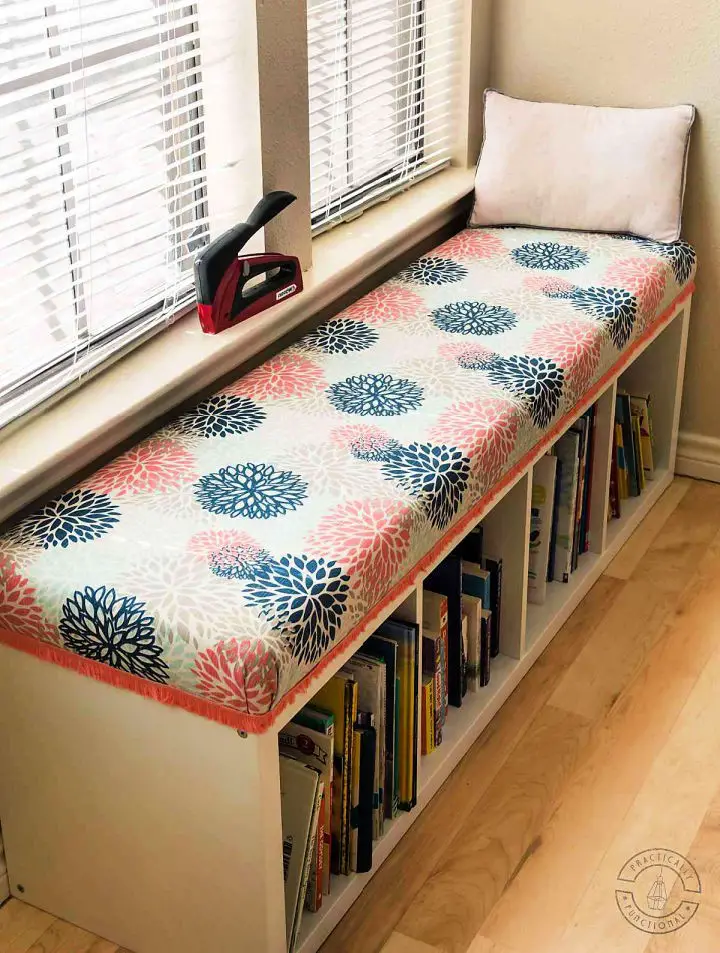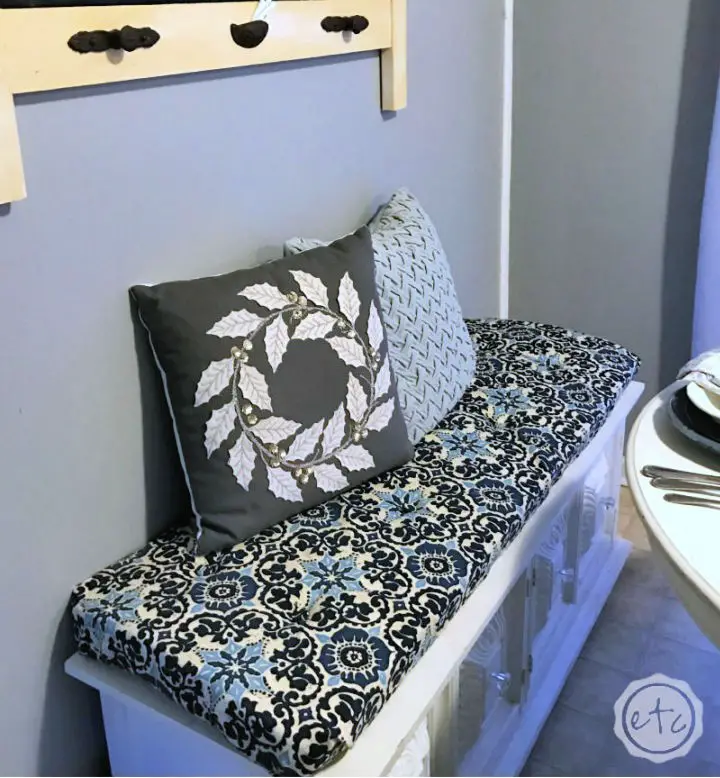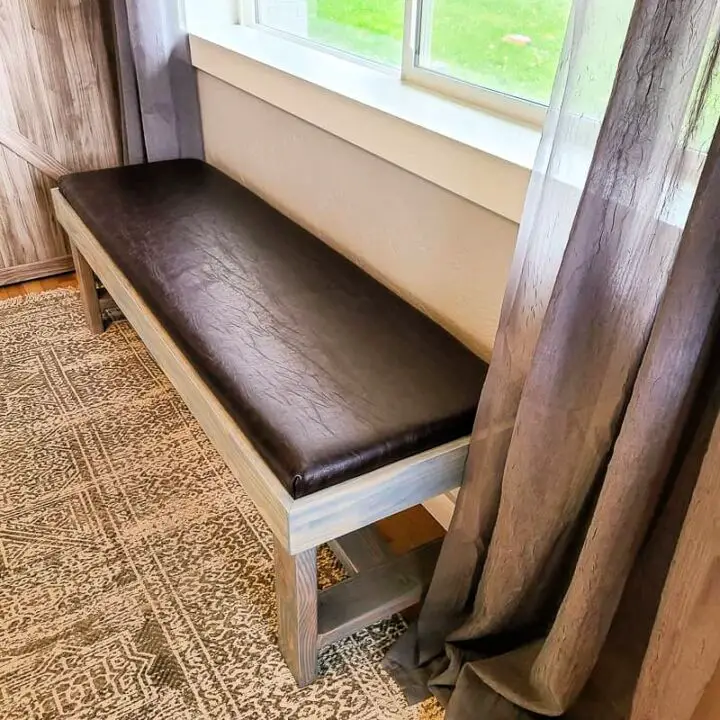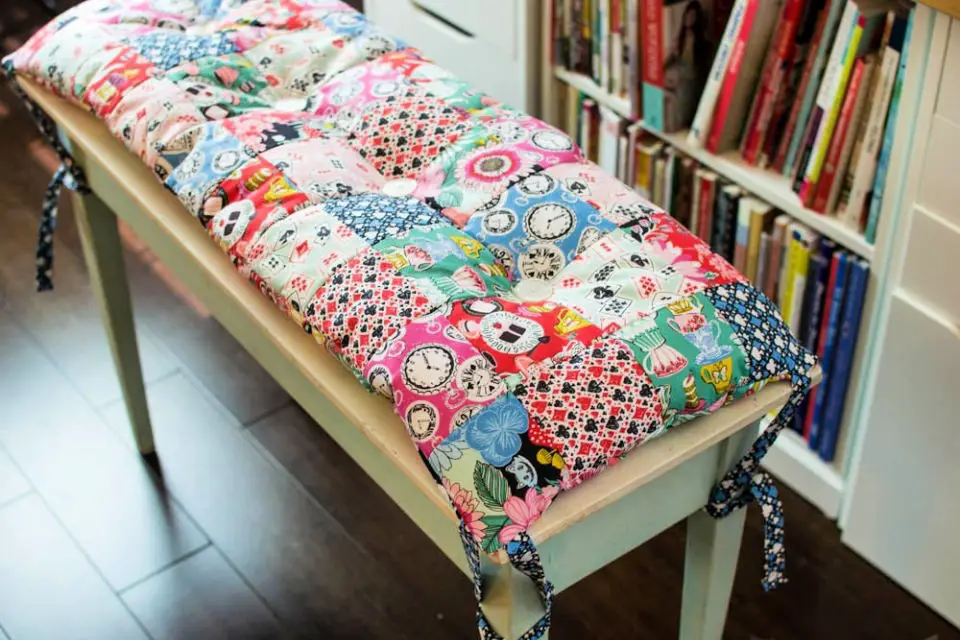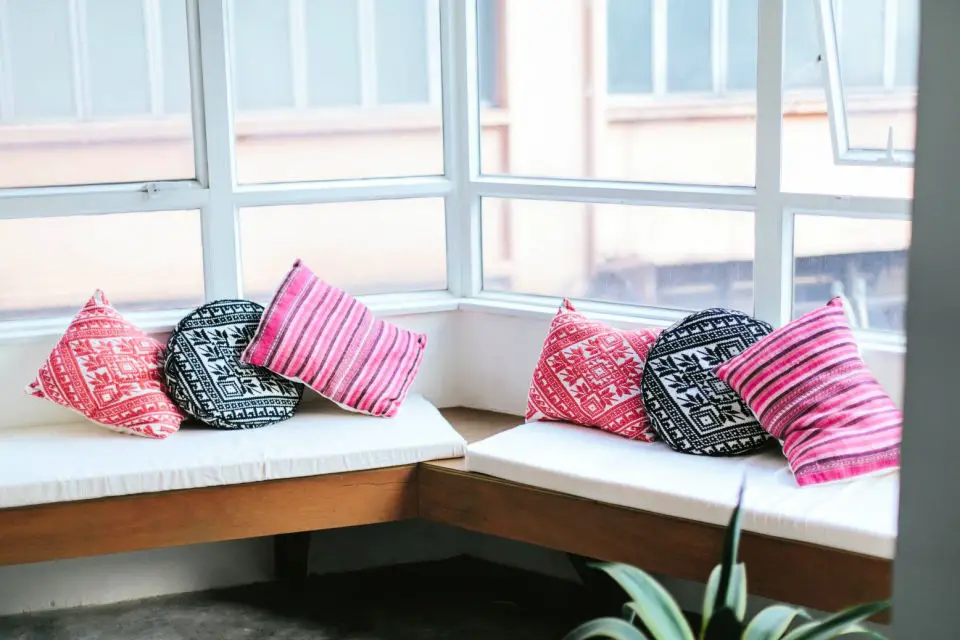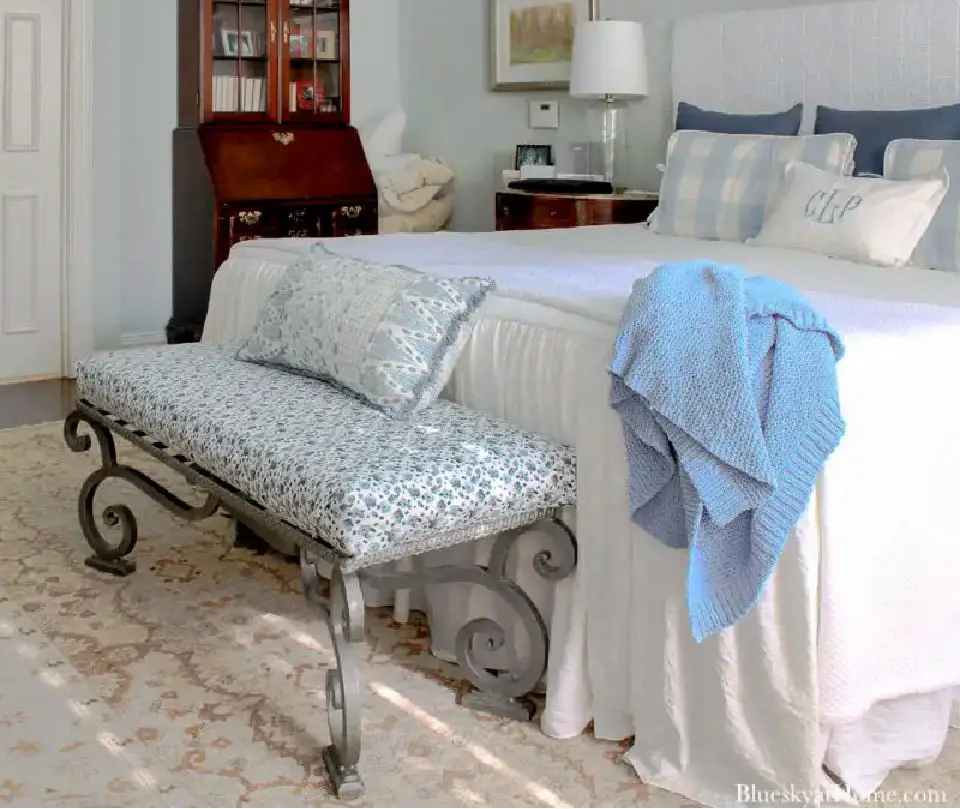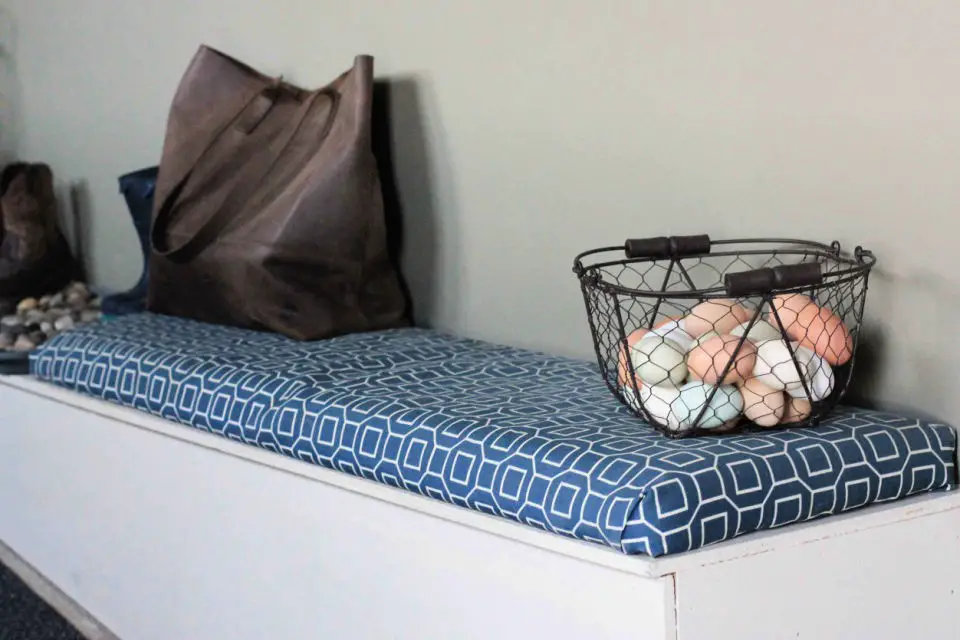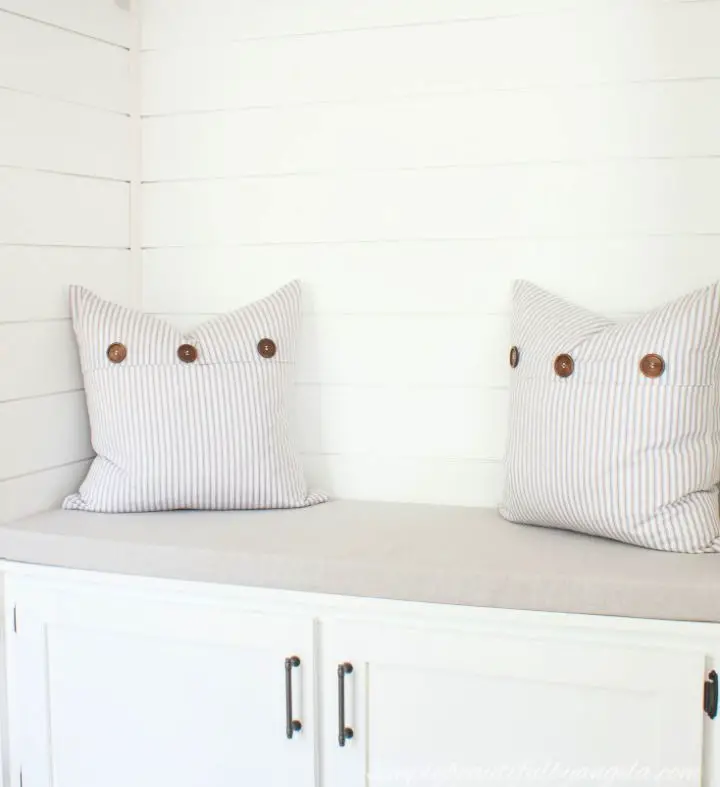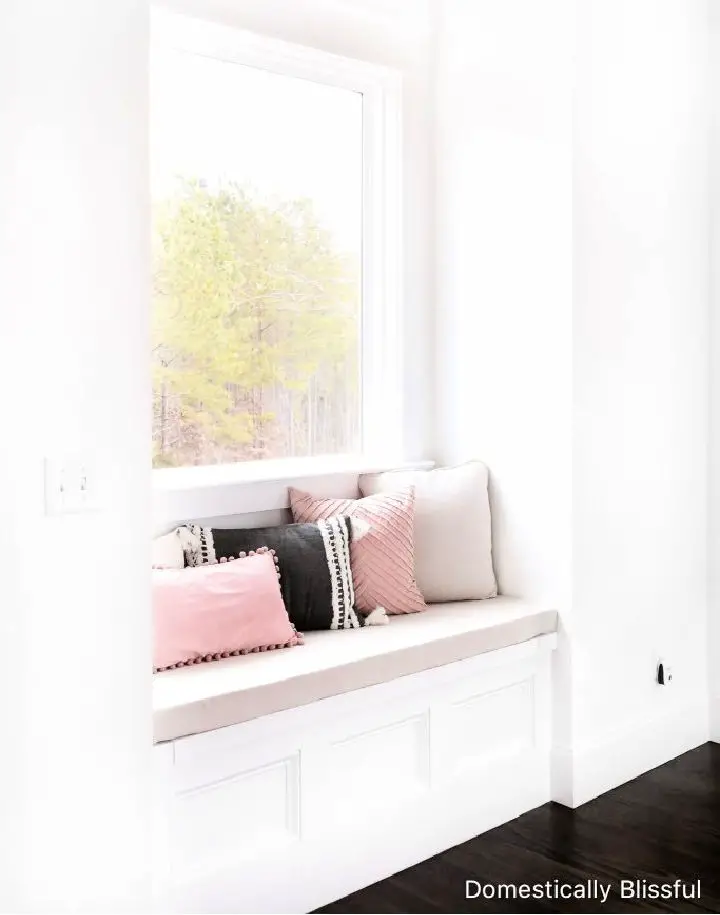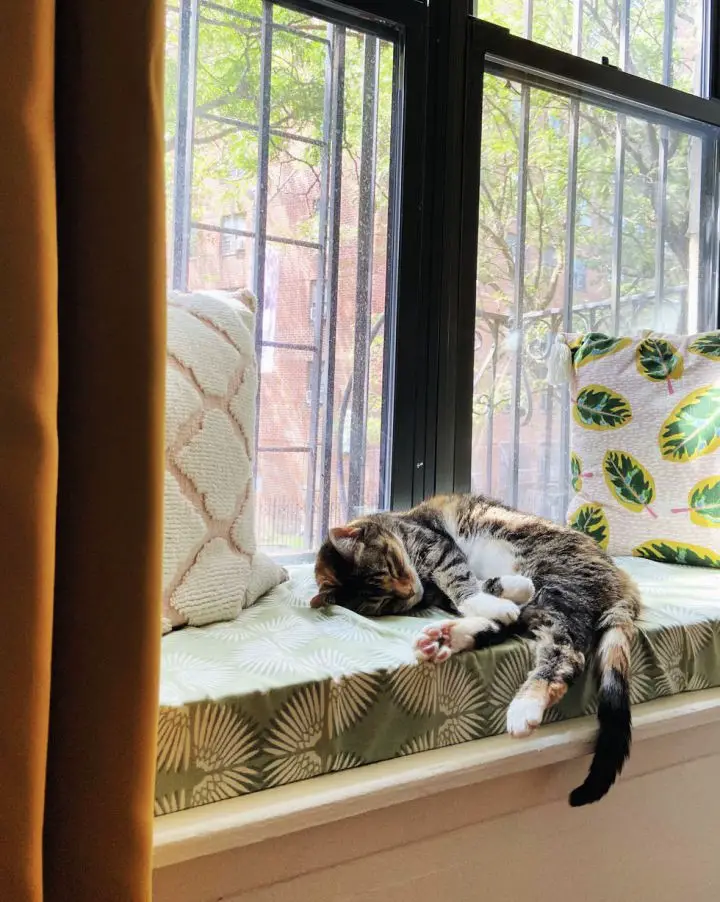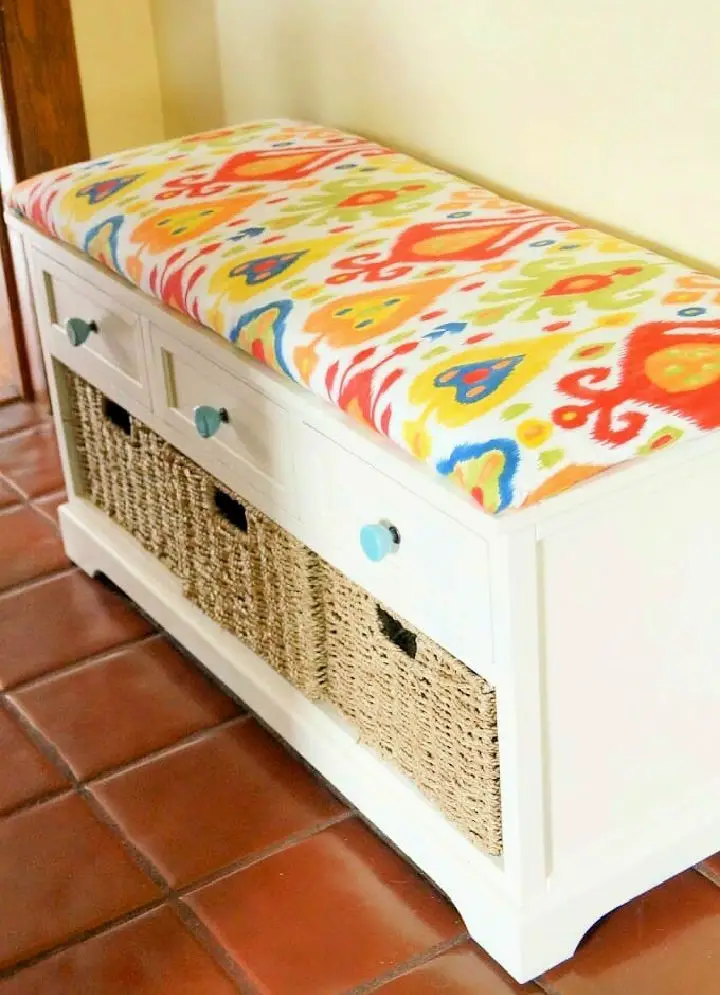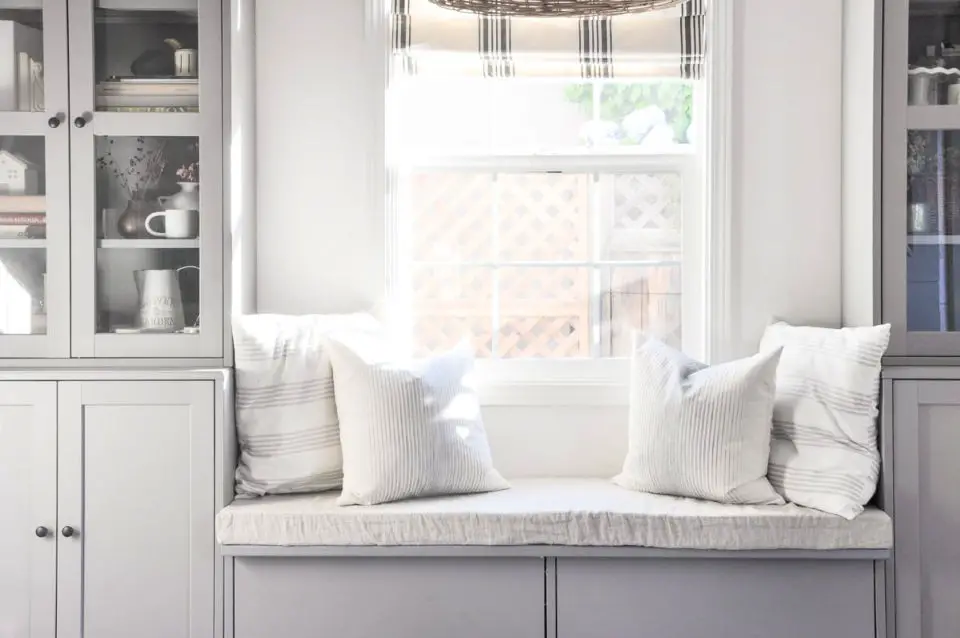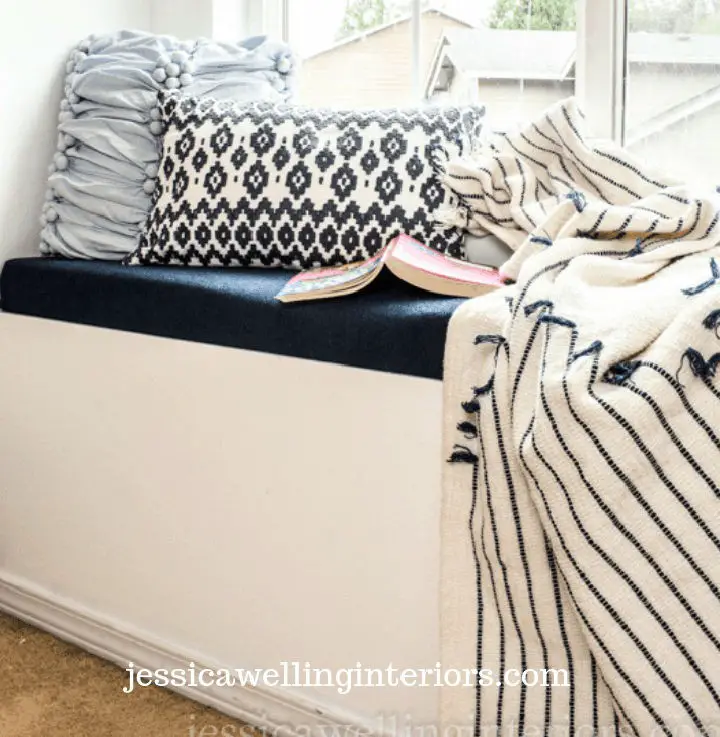
Transforming a bench with a DIY cushion can be a simple yet effective way to add both comfort and style to any seating area. Our comprehensive guide features 25 unique DIY bench cushion ideas, each one showcasing a different theme, fabric choice, and embellishment option. Whether you’re new to crafting or a seasoned pro, our customization tips will help you navigate the process from start to finish. We’ve also included valuable advice on troubleshooting common issues, maintaining your finished product, and even minimizing waste and choosing eco-friendly materials. By following our step-by-step guide, you’ll be able to create a one-of-a-kind bench cushion that perfectly reflects your personal style. And if you have any questions or concerns along the way, our FAQ section is here to provide answers on everything from fabric choices to cushion comfort.
How to Make a Bench Cushion – Step by Step Guide
Get comprehensive instructions on crafting a bench cushion by following our exhaustive, easy-to-follow tutorial.
What You’ll Need:
To create a comfortable and visually appealing cushion, you’ll need to gather the following essential materials. First, choose foam of the desired thickness and size to serve as the foundation of your cushion. Next, select a suitable underlining material that will provide the necessary support and structure. For the decorative fabric that will cover the cushion, opt for a design that complements your desired aesthetic. The length of the zipper will depend on the size of your cushion, so ensure you have one that’s proportional to your project. In terms of cutting tools, you’ll need scissors or a rotary cutter to efficiently trim your materials. For larger or thicker materials, an electric kitchen knife or foam cutter may be necessary. When it comes to sewing, make sure you have a reliable machine with a straight stitch and a zipper foot attachment to ensure smooth and accurate construction. Thread is another crucial component; choose nylon or polyester based on whether the cushion will be used indoors or outdoors. To facilitate the sewing process, utilize seamstick (basting tape) to temporarily hold your materials in place. Finally, have a measuring tape, ruler or straightedge, and marker or chalk on hand to ensure precise measurements and accurate marking of your materials.
Step by Step Instructions
Step 1: Cut the Foam
To start, determine the desired dimensions of your finished cushion. To accommodate the fabric and seams, add approximately 3/8 inch to each side of these measurements. Next, employ an electric kitchen knife to trim the foam to the adjusted dimensions, being mindful to keep the blade straight for a precise cut.
Step 2: Pattern the Bottom Plate
To begin, carefully position your foam piece onto the underlying material, tracing its perimeter to create an outline. Next, draw a new line approximately one-half inch (0.5 inches) inside this traced outline – this will serve as your cutting guide. Using scissors or a craft knife, carefully cut along this inner line to liberate the foam from the underlining material.
Step 3: Attach the Zipper
When preparing your zipper for sewing, it’s crucial to ensure you have enough length. To achieve this, measure and cut the zipper about 4-5 inches longer than required. Once you’ve done this, position the zipper along one edge of the bottom plate, taking care that it remains centered and extends slightly beyond the fabric edges. Secure the zipper in place by sewing it down, then create a small slit in the underlining material to allow for easy access to the zipper pull.
Step 4: Prepare the Top Plate and Facing
When working with decorative fabric for your cushion, start by tracing an outline around the foam block on the wrong side of the material. To determine the width of the facing – which is the sides of the cushion – subtract approximately 1/2 inch from the original foam thickness. This will give you the correct measurement to draw a new outline around the initial trace. The outer line you create will serve as your cut line. Next, extend lines at each corner to ensure clean cuts when cutting out the fabric squares. Once complete, baste and sew along these edges to form the plate and facing edges.
Step 5: Sew Together the Plates
To complete the construction of your cover, start by securing the top plate’s built-in facing to the prepared bottom plate using basting tape. As you do this, make sure to align the center marks you created earlier on both plates to maintain the correct orientation. Once the facing is in place, sew the two plates together, leaving a 3/8 inch seam allowance to ensure a secure and professional-looking bond.
Step 6: Insert Zipper and Bottom Plate
To complete the zipper installation, first join the two plates by sewing them together. Next, secure the open end of the zipper to the opposing edge of the lower plate, guaranteeing accurate alignment and temporary attachment through basting stitches prior to finalizing the seam.
Step 7: Insert Foam and Final Touches
To finish your custom cushion, begin by turning the cover inside out and gently placing the foam block within. Ensure it’s properly seated in each corner, smoothing out any wrinkles to achieve a seamless fit. Once the foam is evenly distributed, close the zipper and admire your newly completed cushion.
Video Tutorial
For those who learn better through visual demonstrations, a step-by-step video tutorial is available on Sailrite’s YouTube channel, providing a comprehensive walkthrough of the box cushion-making process. The video serves as a valuable complement to this written guide, allowing readers to see each technique in action and reinforcing their understanding of the instructions.
Customization Tips for DIY Bench Cushions
Transforming a DIY bench cushion into a personalized masterpiece is an inviting experience that combines creativity with practicality. To infuse your home decor with a touch of uniqueness, consider these insightful pointers, designed to guide you in customizing your bench cushions to perfection.
Choose a Theme
To get started on designing your perfect cushion, begin by selecting a theme or color scheme that resonates with you. This can be influenced by various factors, including seasonal trends – think warm and cozy hues for fall or vibrant patterns for summer – as well as the existing decor in your room, which can serve as a great starting point to build upon. Alternatively, draw inspiration from your personal interests, such as your love of gardening or music, and incorporate elements that reflect these passions into the design. By considering these factors, you’ll be able to create a unique and meaningful cushion that reflects your individual style.
Selecting Fabrics
When selecting fabric for your cushion, the choice can significantly impact its overall appearance. To ensure a durable and low-maintenance option, consider opting for fabrics such as canvas or denim, which are well-suited for high-traffic areas. For a touch of sophistication, soft fabrics like velvet or chenille can add a luxurious feel. Alternatively, if your cushions will be used outdoors, choose fabrics specifically designed for outdoor use to withstand the elements.
Adding Embellishments
Elevate your cushions with thoughtful embellishments that add depth and personality to your space. To achieve a polished appearance, consider adding piping along the edges, which provides a seamless finish. Alternatively, incorporate buttons in strategic locations, such as the center or along tufting lines, for a timeless look reminiscent of classic design. For a more free-spirited aesthetic, consider adding tassels or fringes to give your cushions a bohemian flair.
Personalization Techniques
Elevate your cushions to a new level by incorporating personalized elements that reflect your unique style and personality. This can be achieved through various methods, including embroidery, which allows you to add meaningful names, initials, or designs that hold sentimental value. Alternatively, iron-on patches provide a wide range of shapes and themes to choose from, enabling you to express yourself in a fun and playful way. If you’re feeling creative, fabric paint offers the opportunity to create your own unique patterns or write quotes that reflect your personality. With these personalized touches, your cushions will not only add a pop of color to your space but also tell a story and become a meaningful part of your home’s décor.
Combining Textures
When it comes to designing your cushions, consider combining different textures to add depth and visual interest. This can be achieved by pairing smooth and rough textures, such as satin with burlap or cotton with silk. You can also mix thick and thin textures like wool and linen to create a unique look. By incorporating these texture combinations into your design, you’ll not only create comfortable cushion benches but also add an element of style and creativity. Don’t be afraid to experiment and have fun with the process!
Troubleshooting Common Issues with DIY Bench Cushions
When embarking on a DIY bench cushion project, it’s not uncommon to run into minor setbacks. Fortunately, being prepared for these challenges can make all the difference in ensuring a smooth and successful outcome. Here are some expert tips on how to overcome common obstacles and achieve a professionally-looking finish.
Uneven Filling
When a beloved cushion starts to feel lumpy or uneven, it’s time to take action. The solution lies in revitalizing its inner workings. Start by removing any excess filling and then redistribute it outside of the cushion’s casing. This will help restore the desired level of plushness and comfort. Once you’ve fluffed up the filling to your liking, reinsert it into the cover for a seamless finish.
Fabric Puckering
When dealing with puckered fabrics after sewing, it’s essential to address two common culprits: the sewing machine’s tension and the choice of needle. Firstly, ensure that the tension on your machine is not too tight, as this can cause the fabric to pucker. Secondly, make sure you’re using a needle designed specifically for your fabric type. By taking these simple steps, you can prevent puckering and achieve smooth, even seams.
Zipper Issues
When encountering issues with zippers that get stuck or refuse to close properly, there are a couple of simple yet effective solutions to try. First, take a pencil and run the tip along the teeth of the zipper. This will help smooth out any irregularities and ensure a seamless glide. Additionally, double-check that the fabric isn’t caught in the zipper track, as this can often be the culprit behind stubborn zippers. By addressing these potential obstacles, you should be able to get your zipper moving smoothly once again.
Maintenance and Care for DIY Bench Cushions
To extend the life of your DIY bench cushions, it’s essential to implement a regular maintenance routine. By following these simple steps, you’ll be able to keep your cushions looking like new for a longer period.
Regular Cleaning
To maintain the cleanliness and extend the lifespan of your furniture, it’s essential to attend to its cushions first. Begin by vacuuming them thoroughly to eliminate any accumulated dust, dirt, or crumbs that may be compromising their texture and appearance. Once you’ve removed the loose debris, you can move on to addressing any stubborn stains that may have appeared. For this task, opt for a mild detergent and warm water, gently blotting the stain rather than rubbing it to prevent further damage.
Seasonal Storage
When the seasons change and your storage needs shift, make sure to keep your store cushions in a cool and dry environment. This can be achieved by storing them in a location that maintains a consistent temperature between 60°F to 70°F (15°C to 21°C) and humidity level of around 40% to 50%. Additionally, consider using breathable bags or containers with adequate ventilation to prevent the buildup of moisture and subsequent growth of mold or mildew.
Sunlight Protection
When it comes to maintaining the appearance of your outdoor furniture, two crucial steps can make all the difference. First, take the time to regularly rotate the cushions to ensure that any fading or discoloration occurs evenly across the surface. This simple act can help prevent unsightly patches from forming and keep your furniture looking its best. Additionally, if your cushions are exposed to direct sunlight, consider investing in UV-resistant fabric options. Not only will this protect the material from damage caused by harmful ultraviolet rays, but it will also help maintain their vibrant colors and overall integrity.
Understanding the Environmental Impact of DIY Bench Cushions
As you embark on crafting DIY bench cushions, it’s essential to factor in the ecological implications. By adopting environmentally conscious approaches, you can significantly minimize your ecological footprint and play a part in promoting sustainability.
Choosing Sustainable Materials
When it comes to choosing materials for your products, consider opting for options that align with sustainable and eco-friendly practices. One approach is to focus on organic fabrics, such as cotton or wool, which are cultivated without the use of harmful pesticides. This not only benefits the environment but also ensures a healthier production process. Another option is to select materials made from recycled plastics or repurposed textiles. These alternatives reduce waste and conserve natural resources. For added sustainability, look for biodegradable fibers like jute or hemp that can decompose naturally. By incorporating these eco-conscious materials into your products, you’re taking a crucial step towards minimizing your environmental footprint.
Eco-Friendly Filling Options
For eco-friendly enthusiasts, the choice of filling can be a significant consideration. Three options stand out as particularly appealing due to their natural and sustainable characteristics. Firstly, there’s natural latex foam – a durable and biodegradable material that showcases the benefits of renewable resources. Then, there’s recycled polyester fiberfill, made from repurposed plastic bottles, providing a clever solution for reducing waste. Finally, organic kapok offers a fluffy plant-based alternative that’s not only gentle on the environment but also biodegradable.
Minimizing Waste
To minimize waste and optimize your creative endeavors, consider the following strategies: Firstly, take precise measurements when cutting materials to avoid unnecessary scraps. This approach not only reduces waste but also ensures a perfect fit for your project. Additionally, get creative with leftover fabric by transforming it into smaller items like coasters or patchwork designs. If there’s still excess material remaining, consider donating it to local schools or craft groups, where it can be repurposed or reused in various projects. By adopting these practices, you’ll not only reduce waste but also contribute to a more sustainable and eco-friendly crafting environment.
Low-Impact Dyes and Treatments
When it comes to selecting dyes and treatments for your hair, there are several key factors to consider. For starters, opt for water-based options that are not only easier to clean up but also significantly less toxic. This is especially important if you’re looking to reduce your environmental footprint or simply prefer a more natural approach. Another crucial consideration is the chemical content of the dye or treatment. Seek out products with low levels of harsh chemicals and instead focus on those that prioritize non-toxic, eco-friendly formulations. Finally, don’t forget about certifications! Products bearing certifications from organizations like OEKO-TEX have undergone rigorous testing to ensure they meet certain standards for environmental sustainability.
FAQs About DIY Bench Cushions
As you embark on the journey of creating a DIY bench cushion, you may encounter uncertainties. To alleviate these concerns, we’ve compiled a list of frequently asked questions and their corresponding answers, designed to guide you through the process from start to finish.
What materials do I need for DIY bench cushions?
To embark on this DIY adventure, you’ll require a few essential materials: a suitable fabric, the desired filling, and a reliable sewing machine or a trusty needle and thread. Additionally, you’ll need to have scissors at your disposal, as well as a measuring tape for precise measurements. Depending on the specific design of your project, you may also need to incorporate zippers or buttons for a secure closure.
How do I choose the right fabric?
When choosing a fabric for your cushion, consider its intended purpose – will it be used indoors or outdoors? Selecting a material that’s suitable for the environment is crucial for durability and longevity. For example, cotton may be a great option for indoor use, while waterproof materials are better suited for outdoor settings.
What’s the best filling for comfort and durability?
When it comes to choosing the perfect filling material, foam is often favored for its durability and comfort. However, polyester fiberfill offers an alternative option that provides a softer, more tactile experience.
Can I make a cushion without a sewing machine?
When it comes to crafting a unique and personalized cushion, you’re not limited to store-bought solutions. In fact, there are two primary approaches you can take: hand-sewing and no-sew methods. Hand-sewing involves manually stitching the fabric together using your own skills and expertise. On the other hand, no-sew options utilize fabric glue or other adhesives to secure the material without requiring any needlework.
How do I measure my bench for a cushion?
To create your custom bench cushion, start by measuring the exact length and width of the bench frame. Be sure to factor in additional inches to account for seam allowance and the thickness of the cushion material you’ll be using. This will ensure a proper fit and prevent any gaps or bunching once the cover is in place.
How can I make my cushion waterproof?
When it comes to protecting your gear from water damage, consider using a waterproof fabric specifically designed for textile use. Alternatively, opt for a high-quality waterproofing spray that’s been formulated with textiles in mind.
What are some easy ways to customize my cushion?
Consider elevating your DIY projects with the addition of piping, tufting, or decorative trim. For an extra layer of customization, incorporate fabric paint or iron-on patches to infuse your creations with a unique personality.
How do I maintain my DIY cushion?
To maintain the appearance and longevity of your furniture, it’s essential to adopt a consistent cleaning routine. This involves regular vacuuming to remove dirt and debris, as well as prompt spot-cleaning of any stains that may arise. For more thorough cleans, be sure to refer to the fabric care instructions provided by the manufacturer. By following these simple yet effective steps, you’ll be able to keep your furniture looking its best for years to come.
Can I wash my DIY bench cushion?
When it comes to cleaning your sofa, the first step is to check if the cover is removable and the fabric is washable. If both conditions are met, you’re in luck – you can give your sofa a deep clean without worrying about causing any damage. However, if the cover isn’t removable or the fabric isn’t designed for washing, it’s best to stick with spot-cleaning only to avoid damaging the material.
How can I make my cushion eco-friendly?
When it comes to crafting your next creative project, don’t forget to think about the environmental impact. Opt for organic or recycled materials whenever possible, as these not only reduce waste but also promote a more eco-friendly approach. Additionally, consider implementing sustainable practices throughout the creation process, such as minimizing water and energy usage.
What if my cushion isn’t comfortable after making it?
As you adjust to your new mattress, it’s essential to find the perfect filling. Experiment with different positions and pressure points to discover what works best for you. Whether it’s adding a layer of comfort or removing excess material, make sure the filling is tailored to your unique needs.
25 DIY Bench Cushions
Elevate the ambiance of your living space by revamping your seating area with a DIY approach. Transforming plain benches into cozy and inviting spots is easier than you think, thanks to our comprehensive guide on creating custom bench cushions. With 25 step-by-step tutorials at your disposal, you can confidently tackle the project and enjoy the fruits of your labor in no time.
No Sew DIY Bench Cushion
Elevate any room with a cozy DIY bench cushion, requiring just over an hour of your time and no sewing skills whatsoever. This ingenious no-sew solution transforms an IKEA Kallax cubby storage unit into a luxurious custom-made cushion, perfect for upgrading window seats, outdoor benches, or reading nooks. Simply turn the storage unit on its side, add some fabric of your choice, and use a staple gun to secure it in place – voilà! A plush, inviting bench cushion that’s as easy as it is impressive. No expertise necessary, just a willingness to give your seating area an instant makeover.
How to Make Bench Cushion Without Sewing
With no need to rummage through woodworking tools or sewing kits, you can effortlessly craft a plush and stylish seat cushion using basic materials. The tutorial takes care of all the heavy lifting, providing step-by-step guidance that even beginners can follow with ease. From choosing fabrics that reflect your personal style to cutting and assembling the pieces, the entire process is streamlined for quick results. Before you know it, you’ll be lounging comfortably on your new DIY bench cushion, ready to enjoy your outdoor or indoor space. So why wait? Start making today and add a touch of flair to your home without breaking a sweat!
Make Your Own Tufted Bench Cushions
Transform your home with the elegance of DIY tufted bench cushions. This modern and captivating design is easily achievable through a simple crafting process.
Begin by selecting high-quality upholstery thread and large, curved buttons that will serve as the focal point for your project. To maintain a cohesive look, use the same fabric to cover all sides of the bench, ensuring a seamless fit. Alternatively, feel free to get creative and mix different textures of fabrics to create an intriguing contrast.
Once you’ve secured the fabric in place, sew on those buttons to complete the tufted design. With just a few steps, you can effortlessly revamp any old bench into a stunning piece that’s sure to draw attention – all within a surprisingly short timeframe!
Easy DIY Wood Bench Cushion
Handcrafted with functional flair, this DIY wood bench cushion is the perfect blend of form and function for any bedroom. The sturdy wooden frame, built from solid wood, provides ample storage space to stow away two suitcases, while its modern design ensures seamless integration into your home’s interior aesthetic. The bench’s cushion can be effortlessly upholstered with faux leather or vinyl, adding a touch of luxury to the overall piece. As both stylish and practical, this easy-to-assemble wooden bench is ideally suited for storing seasonal clothing at the foot of your bed or beneath a window – making it an invaluable addition to any bedroom.
Modern DIY Bench Cushion With Leather Straps
Transform your space with the charm of a modern DIY bench cushion project, perfect for those seeking a comfortable and stylish addition. As an intermediate sewing project, it’s ideal for adding warmth and texture to any room. Our leather straps make it effortless to attach the handmade cushion to your chosen bench. Not only will this unique piece elevate the ambiance, but also provide support and comfort. The organic texture and contemporary design of this fabric cushioning blend seamlessly with any furniture, making it a perfect companion for your home’s interior. Let us guide you through the process of crafting a stunning bench cushion that will undoubtedly become the crowning glory of your interior.
How to Make Bench Seat Cushion
Elevate your home decor with a creative DIY bench seat cushion that’s surprisingly easy to make. Even novice sewers can achieve professional-looking results with just basic sewing skills, 6 hours of spare time, and some simple materials. By choosing the perfect fabric and pattern, you’ll create a show-stopping piece of furniture that will leave your friends green with envy. So why not take on this fun challenge today and unleash your inner designer?
How to Sew a Bench Cushion – Free Pattern
Transform everyday items into unique creations with DIY sewing! By repurposing scrap metal, you’ll bring a one-of-a-kind bench cushion to life. As you work with fabric and a sewing machine, tap into your creativity and imagination, savoring the sense of accomplishment that comes from upcycling ordinary objects into extraordinary pieces. If crafting or working with your hands is your passion, there’s no substitute for creating your own furniture from scratch. With persistence, patience, and the right guidance, you can craft a stunning bench cushion that adds warmth and comfort to any space. So why wait? Slip on your gloves and start building today!
Handmade No Sew Bench Cushions
Want to refresh your outdoor furniture without sacrificing your budget? Look no further than the world of no-sew bench cushions. This cost-effective approach to customization offers a multitude of possibilities for personalizing your outdoor space, from classic tufted designs to creative fringe styles. With no need for a sewing machine or specialized materials, you can unleash your creativity and create one-of-a-kind pieces that perfectly complement any setting. Whether you’re in the market for affordable bench cushions or unique, handmade creations, DIY no-sew options have got it all.
Free Patchwork Bench Cushion Sewing Pattern
A DIY patchwork bench cushion can bring a burst of creativity and personality to any room in your home. With only basic sewing skills required, such as stitching straight lines, inserting filling, and attaching buttons, you can create a stunning bench cushion that appears to have taken days to craft! This comprehensive free pattern will walk you through the process of making your one-of-a-kind masterpiece, so don’t hesitate to showcase your handiwork – with this project, everyone’s a winner. The colorful patchwork design is mesmerizing, injecting vibrancy into any dull space and boasting an intricate pattern that truly makes it stand out. Moreover, tying the patches together at the end adds an adorable touch that’s uniquely yours!
How to Make Seat Cushions for Bench
Transforming the comfort and style of your bench with homemade seat cushions is a straightforward process that requires minimal time and effort. With just safety pins, fabric, foam, and scissors as necessary tools, you can complete this project in under 10 minutes without needing to wield a needle and thread. The key lies in cutting the foam to size using your preferred method – be it scissors or a knife – and then wrapping the fabric snugly around the cushion’s edges before securing it firmly with safety pins. This simple yet effective approach not only adds a touch of elegance to your bench but also provides an extra layer of comfort for those relaxing moments. Perfect for sprucing up your window seating area without breaking a sweat, this DIY project is a great way to breathe new life into your space – so why wait? Get creative and start crafting your own unique seat cushions today!
Make Your Own No-Sew Bench Cushion
Elevate your seating space with a DIY no-sew bench cushion that’s easier to create than you think. Without any sewing skills required, you can transform an old bench into a comfortable and stylish haven in under an hour using just a few simple supplies. The best part? You get to customize the cushion size to fit your unique decor perfectly. To get started, gather foam, batting, fabric spray adhesive, scissors, measuring tools like yardsticks and pencils, and dressmaker pins. With these essentials at hand, you’ll be well on your way to creating a dream seat that’s tailored to your personal style.
How to Make Bench Cushions
Elevate the ambiance of your home with this DIY bench cushion, a stylish and comfortable addition to any room. Without the need for sewing, this project is perfect for crafty beginners or those short on time. The plush fabric ensures all-day lounging comfort while its durability makes it suitable for daily use. With an array of unique patterns and colors to choose from, you can easily add warmth and character to your space. Plus, by crafting the cushion yourself, you’ll save money and achieve a professional-grade finish. Unleash your creativity and give new life to your furniture today – start making your bench cushion now!
Make a Removable Bench Cushion
Transform your outdoor furniture into a haven of relaxation and practicality with this ingenious DIY removable bench cushion. Whether you’re seeking a cozy spot to unwind or an additional seat for gatherings, this versatile design checks all the boxes. With its luxurious foam padding providing unparalleled comfort and support, and a removable cover that makes cleaning a breeze, you’ll enjoy the perks of premium seating at a fraction of the cost. Imagine spending your weekend getaways in style, knowing that every moment will be spent in utmost comfort. This fantastic removable bench cushion is poised to elevate your outdoor experiences, allowing you to savor each precious hour with family and friends.
IKEA Besta Bench Cushion Hack
Transform your IKEA Besta bench into a luxurious seat with a stylish twist using leftover plywood from other projects or inexpensive pieces from the local hardware store. This DIY cushion hack is perfect for those seeking an affordable way to make their furniture stand out, and it’s surprisingly easy to achieve. With minimal supplies required, you can create a beautiful bench cushion that adds character to any room and offers plenty of opportunities for customization to make something truly unique.
DIY Bench Seat Cushion Using a Bed Pillow Upcycle
Want to add a touch of personality to your home without breaking the bank? Consider repurposing an old bed pillow into a one-of-a-kind DIY bench seat cushion. This budget-friendly project requires minimal materials – think bed pillow, hand towel, fabric of your choice, hot glue sticks, and gun – but yields a stunning result that rivals high-end design. Perfect for slipping under a dressing table or placing in any room, this customizable cushion combines vibrant colors and textures to instantly revitalize your space. Not only will it catch the eye, but it’s also designed with comfort in mind, making it perfect for lounging. So why not get creative and craft this unique bench seat cushion using an upcycled bed pillow? Your guests are sure to be impressed!
Homemade Window Seat Cushion
Create a stunning DIY window seat cushion without sewing skills by repurposing an old curtain as the fabric. This easy-to-make project requires only basic supplies and promises a cozy addition to any room. Whether you opt for bold and unique or subtle and calming, the result is guaranteed to add instant style and warmth. Imagine enjoying relaxing afternoons in front of your beautiful new window seat – it’s just a DIY away!
No Sew DIY Window Seat Cushion Under $50
Transform your window seat into a cozy retreat without sacrificing style or breaking the bank. This easy-to-make, no-sew DIY window seat cushion requires just $50 in supplies and can be customized to fit any space in under 20 minutes. Perfect for those seeking a quick fix that yields professional-looking results. Simply cut the cushion to size and voilà! You’ll have a luxurious seating area that rivals magazine spreads.
Simple DIY Bench Cushion in 15 Minutes
Transform your bench with a quick and easy DIY project that requires no sewing skills at all. In just 15 minutes, you can create a customized cushion that matches your personal style and decor. No matter the occasion, this no-sew bench cushion is perfect for adding a pop of color to any room, making it inviting for friends and family. Simply gather some fabric glue and get creative with leftover fabrics or choose a new pattern to give an old house a fresh makeover. This budget-friendly and simple DIY hack is a great way to instantly update your space.
DIY Upholstered Bench Cushion
If you’re eager to create a plush and inviting seating area, this straightforward guide is the perfect place to start. Without requiring any sewing skills, we’ll walk you through the process of crafting a stunning padded cushion seat on plywood. This DIY project promises to deliver a beautiful addition to your home, not only enhancing its aesthetic appeal but also providing a cozy spot for relaxation and unwinding. The key to this project’s success lies in its simplicity – just gather foam padding, fabric, batting, a plywood base, and staples, then add a dash of patience as you assemble the piece. The end result? A sleek and elegant upholstered bench that will provide years of enjoyment. So why wait? Begin making your own DIY upholstered bench cushion today!
No Sew Bench Seat Cushion Pattern
Want to add a personal touch to your home decor without devoting hours to crafting? A DIY no-sew bench seat cushion is the perfect solution. This straightforward project can be completed in under an hour and at a fraction of the cost of store-bought cushions. With a wide range of fabric options available, you can create a unique piece that reflects your personality. From plush velvets to bold geometric patterns, the possibilities are endless. By following simple step-by-step instructions and using high-quality foam inserts, you’ll be lounging in comfort and style in no time. So why not get creative and let your imagination run wild? The result will be a one-of-a-kind cushion that brings joy to any room in your home.
DIY Bench Cushion With Removable Cover
Kick-start your DIY adventure by crafting unique banquette seating cushions, without breaking the bank or sacrificing style. Ditch the idea of custom-made cushions and instead create something truly yours at home.
This project is a breeze to follow, requiring only fabric of your choice, batting, foam pieces, thread, and ties – no plywood necessary! To add an extra layer of personality to your cushion cover, we’ll guide you through the envelope closure technique. This clever method allows for removable covers that can be tailored to fit seamlessly into any home’s interior decor.
DIY Upholstered Window Bench Cushion
With a few simple steps, you can create an inviting and affordable upholstered bench cushion without breaking out the sewing machine. To get started, gather just a handful of supplies: plywood or OSB for the base, 3-inch or 4-inch thick foam for the cushion, and your choice of upholstery fabric or another durable material. This project is perfect for DIY enthusiasts looking to add a touch of elegance to window seats, banquettes, breakfast nooks, benches, and more. Once you have all the necessary materials in place, constructing the cushion takes virtually no time at all – simply attach it to the seat or bench of your choice and enjoy the fruits of your labor. Whether you’re looking to add comfort to an existing piece of furniture or give a lackluster space a much-needed boost, this DIY upholstered window bench cushion is sure to hit the spot. So grab that good book, pour yourself a cup of coffee, and get ready to sink into your newly crafted creation.
How to Make a Tufted Bench Cushion
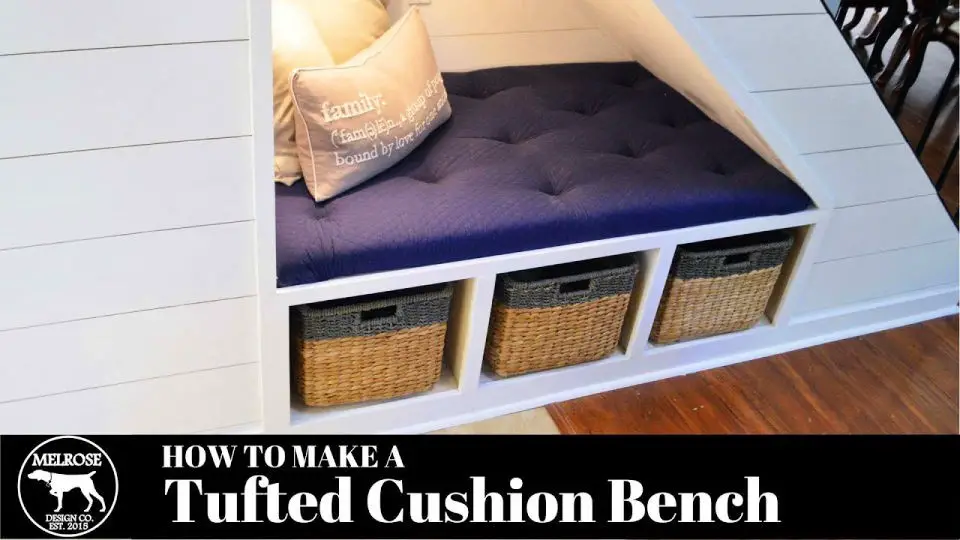
Transform your seating area into a sophisticated oasis with this DIY tufted bench cushion, requiring no sewing skills! By following our simple step-by-step guide, you can effortlessly create a stunning piece that elevates your decor without breaking the bank or investing hours in complicated projects. This versatile project is perfect for crafting cozy reading nooks or stylish upholstered benches indoors or outdoors, offering endless possibilities. With our detailed materials list and easy-to-follow instructions, anyone can bring their creative vision to life and enjoy the added comfort and style that a custom tufted bench cushion provides.
No Sew DIY Window Bench Cushion

Unleash your creativity and transform any room with an eye-catching no-sew DIY window bench cushion. This simple and versatile project requires minimal tools, fabrics, and – most importantly – sewing skills. With its unique design that adds texture and depth without appearing overwhelming, this handmade cushion is not only a comfortable seating option but also a conversation-starting centerpiece for your home. Its timeless appeal makes it perfect for showcasing your DIY prowess and adding a personal touch to any space.
Making Your Own Bench Cushion
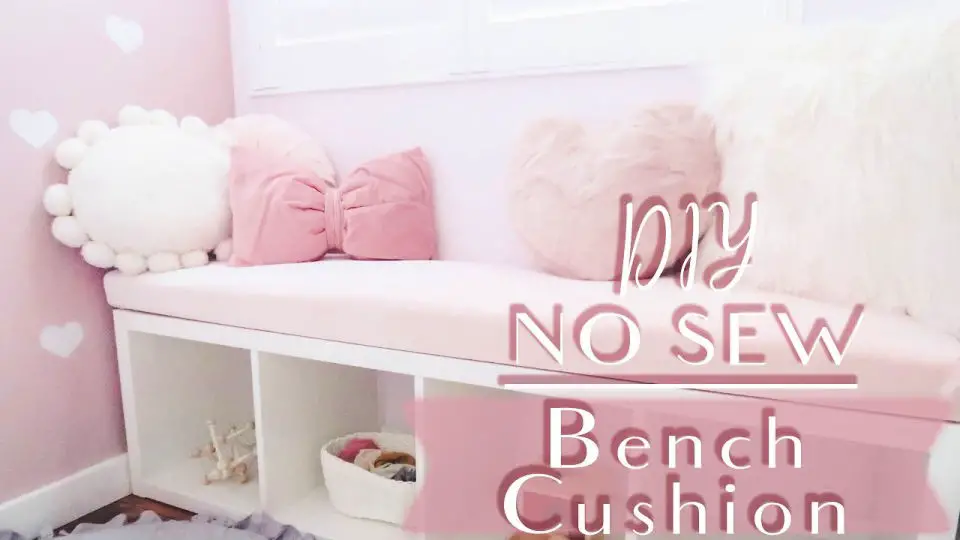
Imagine transforming your living space with a bespoke bench cushion that perfectly complements your décor, all without breaking out the sewing machine. This innovative DIY project is designed to be easy and accessible, even for those with limited sewing experience. With just a few simple materials – including fabric, foam padding, batting, scissors, and a measuring tape – you can create stunning custom cushions that reflect your personal style. The step-by-step tutorial provides a clear path to success, ensuring anyone can achieve professional-looking results without the hassle of complicated sewing techniques. Not only will this project save you money, but it also offers the unique opportunity to infuse your home with a one-of-a-kind piece that truly reflects your personality. So why settle for generic, mass-produced cushions when you can create something special? Start crafting your bench cushion today and discover the joy of DIY creativity.
Free Sewing Pattern for Bench Cushion
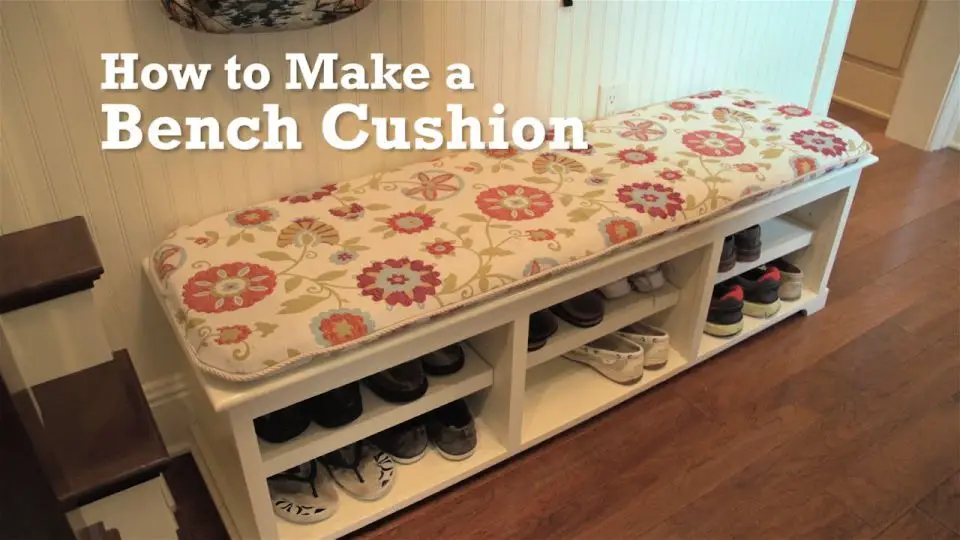
Kick-start your sewing adventure with a fantastic DIY project that’s perfect for any skill level: a stylish bench cushion pattern! This simple yet effective design is ideal for built-in benches in mudrooms or window seats, adding a touch of sophistication and flair with its piped edge. The straightforward step-by-step instructions make constructing this long bench cushion without boxes a breeze, requiring minimal materials to give your home a fresh makeover. Get creative with fabric choices and unleash your imagination – show off your craftsmanship by making one yourself today!
Conclusion:

In the end, taking control of DIY bench cushion-making offers a unique opportunity for self-expression, flexibility, and environmentally responsible choices. By embracing the customization tips we’ve shared and navigating potential hurdles, you can create a cozy and eco-conscious seating arrangement that perfectly suits your needs. Without hesitation, let your imagination run wild and embark on an engaging and fulfilling journey with our comprehensive DIY guide to 25 bench cushion projects.

